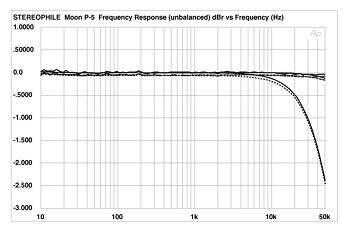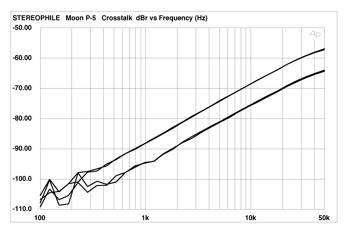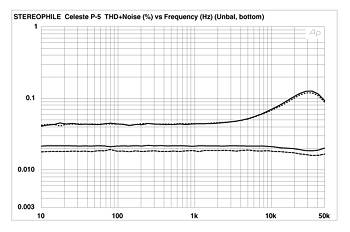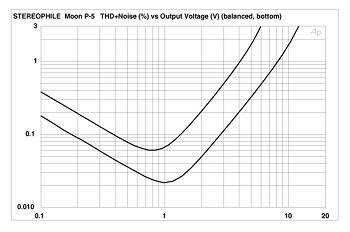| Columns Retired Columns & Blogs |
Simaudio Moon P-5 preamplifier & W-5 power amplifier Measurements, SimAudio Moon P-5
Sidebar 3: Measurements, SimAudio Moon P-5
Unless otherwise noted, the measurements presented are for unbalanced operation. The P-5's output impedance at its line output measured 163 ohms (325 ohms balanced), with insignificant variations with changes in the level control. The input impedance measured 38k ohms, with the left and right channels essentially identical (though they differed slightly in the balanced setting, at 88k ohms left and 78k ohms right). The input impedance dropped to 21k ohms at lower than maximum settings of the level control, measured at both unity gain and at a control setting of "20." The output impedance at the tape output measured 2.7k ohms with a 25 ohm source impedance and 3.1k ohms with a 600 ohm source impedance. This indicates unbuffered tape outputs, but a larger concern is the high impedance at these outputs; the user should exercise caution in matching the tape outputs to a recorder. The latter should have an appropriate (ie, very high) input impedance.
The DC offset at the P-5's outputs was unmeasurable. The preamp is noninverting from its line inputs to its main outputs; in balanced mode, pin 2 is positive. The maximum gain measured 16.9dB unbalanced and 22.9dB balanced. The tracking of the level control was excellent. S/N measured 95.1dB (unweighted) over a 22Hz-22kHz bandwidth, 83.8 (unweighted) from 10Hz to 500kHz, and 97.9dB A-weighted (all ref. 1V). The balanced S/N readings are 91dB, 82.8dB, and 93.3dB—marginally worse than the unbalanced results.
The P-5's frequency response is shown in fig.1; it is slightly flatter at the extreme top end at settings below maximum. Fig.2 shows the P-5's crosstalk. Due to interchannel capacitive coupling, it increases with frequency—a typical result.

Fig.1 Moon P-5, unbalanced frequency response with volume control set (from top to bottom): to "12," unity gain, and maximum ("50") (0.5dB/vertical div., right channel dashed).

Fig.2 Moon P-5, Crosstalk (from top to bottom): R-L, L-R unbalanced; R-L, L-R balanced; (10dB/vertical div.).
The THD+noise result for the P-5 is shown in fig.3. The input levels used for both the crosstalk measurement and the THD+noise vs frequency measurement were 115mV unbalanced and 70mV balanced, which reduced the influence of noise on the readings to a minimum. This is shown graphically in fig.4: the THD+noise percentage vs output voltage results at 1kHz into a 100k ohm load. From fig.4 we see that the output voltage capability of the P-5 is both lower than that of a number of other high-quality preamps and lower than the 5V specified, but more than enough to drive any known power amplifier well beyond clipping.

Fig.3 Moon P-5, THD+noise (%) vs frequency (from top to bottom): balanced, unbalanced).

Fig.4 Moon P-5, distortion (%) vs output voltage into 100k ohms (from bottom to top): balanced, unbalanced.
Apart from the caveat concerning the use of the tape outputs, the objective performance of the SimAudio Moon P-5 should give the prospective user no cause for concern.—Thomas J. Norton
- Log in or register to post comments




































